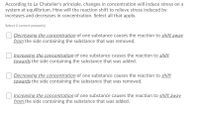
Chemistry
10th Edition
ISBN: 9781305957404
Author: Steven S. Zumdahl, Susan A. Zumdahl, Donald J. DeCoste
Publisher: Cengage Learning
expand_more
expand_more
format_list_bulleted
Concept explainers
Question
thumb_up100%

Transcribed Image Text:According to Le Chatelier's principle, changes in concentration will induce stress on a
system at equilibrium. How will the reaction shift to relieve stress induced by
increases and decreases in concentration. Select all that apply.
Select 2 correct answer(s)
Decreasing the concentration of one substance causes the reaction to shift away
from the side containing the substance that was removed.
Increasing the concentration of one substance causes the reaction to shift
towards the side containing the substance that was added.
Decreasing the concentration of one substance causes the reaction to shift
towards the side containing the substance that was removed.
| Increasing the concentration of one substance causes the reaction to shift away
from the side containing the substance that was added.
Expert Solution
This question has been solved!
Explore an expertly crafted, step-by-step solution for a thorough understanding of key concepts.
Step by stepSolved in 2 steps

Knowledge Booster
Learn more about
Need a deep-dive on the concept behind this application? Look no further. Learn more about this topic, chemistry and related others by exploring similar questions and additional content below.Similar questions
- Which of the following correctly describes chemical equilibrium? A. Concentrations of products are higher than the concentrations of the reactants. B. There are equal concentrations of reactants and products, and the reactions have stopped. C. There are equal concentrations of products and reactants while forward and reverse reactions continue. D. Forward and reverse reactions continue with no net effect on the concentrations of the reactants and products.arrow_forwardFind an Analogy for Equilibrium Constant, Effect of Catalyst on Equilibrium OR Le Chatelier’s Principle. Find a descriptive picture for the chosen analogy and brefily explain the chosen analogy.arrow_forwardSelect all of the true statements regarding chemical equilibrium. The concentrations of reactants and products are equal. The concentrations of reactants and products remain constant. Reactants are being converted to products and vice versa. The rates of the forward and reverse reactions are equal.arrow_forward
- Create a Two-Dimensional Model to represent two terms: -Chemical Equilibrium -Le Chatelier’s Principlearrow_forwardPart III Short Answer 10. List 3 important factors for a reaction to reach equilibrium. Explain why these factors are necessary to reach equilibrium. 1) 2) 3)arrow_forwardWhat is meant by dynamic equilibrium? Include comparison of the rates of forward and reverse reactionarrow_forward
- What is meant by a reaction being at equilibrium? * useing Le Chateliers Principlearrow_forwardFor the generalized chemical reaction A(g) + B(g) C(g) + D(g) determine whether the concentration of D in an equilibrium mixture will (1) increase, (2) decrease, or (3) not change when each of the following changes is effected. a) concentration of C is increased [ Select ] ["increase", "decrease", "no change"] b) concentration of C is decreased [ Select ] ["increase", "decrease", "no change"]arrow_forwardPlease don't provide handwriting solutionarrow_forward
- Select all the TRUE statements about chemical equilibrium. At equilibrium the rates of the forward and reverse reactions are equal. At equilibrium the concentrations of reactants and products remain constant. At equilibrium the reactants are still being converted to products (and vice versa). At equilibrium the concentrations of reactants and products are equal.arrow_forwardIncreasing the concentration of the reactants will slow down the reaction. O true O falsearrow_forward16.1 2arrow_forward
arrow_back_ios
SEE MORE QUESTIONS
arrow_forward_ios
Recommended textbooks for you
 ChemistryChemistryISBN:9781305957404Author:Steven S. Zumdahl, Susan A. Zumdahl, Donald J. DeCostePublisher:Cengage Learning
ChemistryChemistryISBN:9781305957404Author:Steven S. Zumdahl, Susan A. Zumdahl, Donald J. DeCostePublisher:Cengage Learning ChemistryChemistryISBN:9781259911156Author:Raymond Chang Dr., Jason Overby ProfessorPublisher:McGraw-Hill Education
ChemistryChemistryISBN:9781259911156Author:Raymond Chang Dr., Jason Overby ProfessorPublisher:McGraw-Hill Education Principles of Instrumental AnalysisChemistryISBN:9781305577213Author:Douglas A. Skoog, F. James Holler, Stanley R. CrouchPublisher:Cengage Learning
Principles of Instrumental AnalysisChemistryISBN:9781305577213Author:Douglas A. Skoog, F. James Holler, Stanley R. CrouchPublisher:Cengage Learning Organic ChemistryChemistryISBN:9780078021558Author:Janice Gorzynski Smith Dr.Publisher:McGraw-Hill Education
Organic ChemistryChemistryISBN:9780078021558Author:Janice Gorzynski Smith Dr.Publisher:McGraw-Hill Education Chemistry: Principles and ReactionsChemistryISBN:9781305079373Author:William L. Masterton, Cecile N. HurleyPublisher:Cengage Learning
Chemistry: Principles and ReactionsChemistryISBN:9781305079373Author:William L. Masterton, Cecile N. HurleyPublisher:Cengage Learning Elementary Principles of Chemical Processes, Bind...ChemistryISBN:9781118431221Author:Richard M. Felder, Ronald W. Rousseau, Lisa G. BullardPublisher:WILEY
Elementary Principles of Chemical Processes, Bind...ChemistryISBN:9781118431221Author:Richard M. Felder, Ronald W. Rousseau, Lisa G. BullardPublisher:WILEY

Chemistry
Chemistry
ISBN:9781305957404
Author:Steven S. Zumdahl, Susan A. Zumdahl, Donald J. DeCoste
Publisher:Cengage Learning

Chemistry
Chemistry
ISBN:9781259911156
Author:Raymond Chang Dr., Jason Overby Professor
Publisher:McGraw-Hill Education

Principles of Instrumental Analysis
Chemistry
ISBN:9781305577213
Author:Douglas A. Skoog, F. James Holler, Stanley R. Crouch
Publisher:Cengage Learning

Organic Chemistry
Chemistry
ISBN:9780078021558
Author:Janice Gorzynski Smith Dr.
Publisher:McGraw-Hill Education

Chemistry: Principles and Reactions
Chemistry
ISBN:9781305079373
Author:William L. Masterton, Cecile N. Hurley
Publisher:Cengage Learning

Elementary Principles of Chemical Processes, Bind...
Chemistry
ISBN:9781118431221
Author:Richard M. Felder, Ronald W. Rousseau, Lisa G. Bullard
Publisher:WILEY